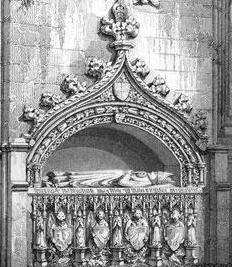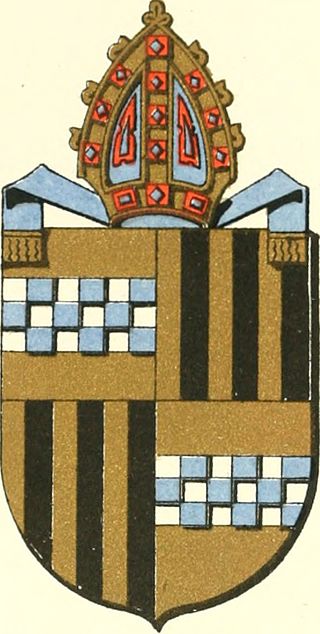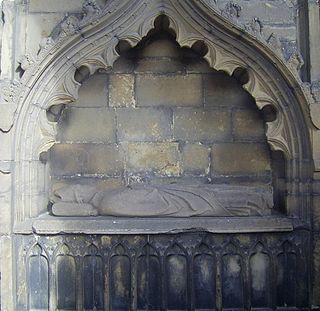Related Research Articles

Robert de Cardeny was a late 14th and early 15th century Scottish cleric. He was the son of one John Cardeny, and brother of the royal mistress Mariota de Cardeny. His early career is obscure. In 1378–80, King Robert II of Scotland petitioned the Pope for a canonry in the diocese of Moray for one Robert de Cardun, despite the fact that the latter already held canonries and prebends in the diocese of Dunblane and Dunkeld. This Robert de Cardun was both a member of King Robert's household and a student at the University of Paris. Robert had graduated from Paris in 1381 as Licentiate. In 1392 he was a receiver of the "English Nation" at Paris and custodian of the Nation's seal. In 1394 Robert was still in Paris, now as Master Robert de Cardeny
Domhnall MacNeachdainn was a 15th-century Dean and Bishop of Dunkeld. He was the nephew of Robert de Cardeny, Bishop of Dunkeld, by Robert's sister, Mairead (Mariota). The latter was also the mistress of King Robert II of Scotland. His father was probably a chief of the MacNeachdainn (MacNaughton) kindred. Domhnall was university trained, and by 1431 had a M. A. and a Doctorate in Decrees. He had been Dean of Dunkeld since the year 1420. He was one of the commissioners of the Scottish king at the Council of Basel in 1433. In 1437, Bishop Robert de Cardeny died and Domhnall the Dean was elected as his replacement. Domhnall died sometime in the year 1440. Since Alexander Myln at least it has been thought that he sought confirmation from the Papacy and died en route, but direct evidence for this is lacking.
James Livingston was a 15th-century cleric from East Lothian in south-eastern Scotland. Born at an unknown date in the 15th century, he was a son of the Laird of Saltcoats. He chose a career in the church, and became rector of the churches of Forteviot and Weme, and vicar of Innerleithen. By 1474, if not earlier, he had become dean for the whole diocese of Dunkeld. After the death of Thomas Lauder, Livingston was chosen as his successor as Bishop of Dunkeld. Although Livingston's appointment was contested at Rome by Thomas Spens, Bishop of Aberdeen, who wanted to be translated to Dunkeld, Livingston was consecrated on 30 June 1476. Livingston's episcopate is relatively obscure; he spent a good deal of time in Edinburgh, where he is witness to several charters. He died at Edinburgh, on 28 August 1483. He was buried in Inchcolm.
Alexander Inglis was a Scottish cleric and royal clerk. He was the son of one George Inglis and his wife Margeret. At some point in his life he had attended university and obtained a Licentiate in Decrees. In 1477 he became Dean of the diocese of Dunkeld, and in 1480 became Archdeacon of St Andrews. On 17 September 1483, after the death of Bishop James Livingston, he was elected to succeed the latter as Bishop of Dunkeld. Inglis ran into difficulty on 22 October, when the Chancellor of the diocese of Aberdeen, George Brown, was also provided as Bishop of Dunkeld. Inglis was styled Bishop-elect in Scotland until 1485, but on 13 June 1484, Brown had been consecrated at the Papal see. Inglis continued to hold his previous posts as Archdeacon and Dean until his death in 1496.
George Brown was a late 15th-century and early 16th-century Scottish churchman. He first appears on record in 1478 as the rector of the church of Tyningham, and is called a clerk of the diocese of Brechin. In 1482, he was selected to be Chancellor of the diocese of Aberdeen.

Andrew Stewart was a 16th-century Scottish noble and cleric. He was a legitimate son of John Stewart, 1st Earl of Atholl and Eleanor Sinclair, daughter of William Sinclair, Earl of Orkney. His paternal grandmother was Joan Beaufort, former queen-consort of Scotland. Andrew chose an ecclesiastical career, held a canonry in Dunkeld Cathedral and was rector of Blair parish church, a church under the control of the earls of Atholl.

Robert Cockburn was a 16th-century Scottish diplomat and cleric.
Donald Campbell was a 16th-century Scottish noble and churchman. He was the son of Archibald Campbell, 2nd Earl of Argyll and Elizabeth Stewart, daughter of John Stewart, 1st Earl of Lennox. From 1522, he was a student of St Salvator's College, at the University of St Andrews. After graduation, he became a cleric in his home diocese, the diocese of Argyll.
Robert Crichton was a 16th-century Scottish Catholic cleric.
Adam de Tyninghame was a 14th-century cleric and, as his name suggests, a probable native of Tyninghame in East Lothian.

Henry de Lichton [de Lychtone, Leighton] was a medieval Scottish prelate and diplomat, who, serving as Bishop of Moray (1414–1422) and Bishop of Aberdeen (1422–1440), became a significant patron of the church, a cathedral builder, and a writer. He also served King James I of Scotland as a diplomat in England, France, and Italy.

John de Winchester was a 15th-century English cleric who distinguished himself as an administrator and bishop in Scotland. Winchester was a student of canon law from 1418, graduating with a bachelorate in 1421.

Andrew Stewart was a 15th-century Scottish prelate and administrator.
Robert Lauder was a Scottish prelate and Nuncio of the 15th century. The Lauder family produced a large number of senior churchman in this period, and alongside Robert can be named William Lauder, Bishop of Glasgow, Alexander Lauder and Thomas Lauder, both Bishop of Dunkeld, and George Lauder, Bishop of Argyll.
John Fraser [also, more commonly then, Frisel or Frisell] was a late medieval Scottish prelate. Born about 1429, or 1430 if later tradition can be believed, with strong connections to the burgh of Linlithgow, Fraser held a variety of high-level ecclesiastical positions in Scotland, including being the first Dean of Restalrig collegiate church before becoming Bishop of Ross in 1497, a position he held until his death in 1507.
Thomas Tulloch [de Tulloch] was a prelate active in the Kingdom of Scotland in the 15th century. A letter of Pope Martin V in 1429 claimed that he was "of a great noble race by both parents". Robert Keith believed that he had the surname "Urquhart", but that is not supported by the contemporary evidence and is probably spurious.
John Bullock O.S.A. was an Augustinian canon and prelate active in the 15th century Kingdom of Scotland. While earning a university degree between 1409 and 1417, Bullock gained several benefices in Scotland, and claimed the headship of St Andrews Cathedral Priory before becoming Bishop of Ross in 1418. He held the latter position until his death, which occurred in either 1439 or 1440.
Dúghall of Lorne [or de Ergadia] was a late 14th century and early 15th century prelate in the Kingdom of Scotland. Probably a MacDúghaill (MacDougall) from the province of Lorne in Argyll, he appears to have studied at the University of Oxford before returning to Scotland for an ecclesiastical and administrative career. He obtained benefices in the diocese of Argyll, Dunkeld, Dunblane and St Andrews, and acted as the secretary and chaplain of Robert Stewart, Earl of Fife, before becoming Bishop of Dunblane. He held the bishopric of Dunblane until his death in 1403.
George Shoreswood or Schoriswood, was a prelate active in the Kingdom of Scotland during the 15th century. He appears to have been of English-speaking origin, from the family of Bedshiel in Berwickshire.
John de Crannach was a 15th-century Scottish scholar, diplomat and prelate. Originating in the north-east of Lowland Scotland, he probably came from a family associated with the burgh of Aberdeen. Like many of his relatives, he flourished in the 15th-century Scottish church. After just over a decade at the University of Paris, Crannach became a servant of the then Dauphin Charles (VII).
References
- Borthwick, Alan R. "Ralston, John (d. 1451/2)", in the Oxford Dictionary of National Biography, Oxford University Press, 2004, retrieved 17 Feb 2007]
- Dowden, John, The Bishops of Scotland, ed. J. Maitland Thomson, (Glasgow, 1912)
- Watt, D.E.R., Fasti Ecclesiae Scotinanae Medii Aevi ad annum 1638, 2nd Draft, (St Andrews, 1969)